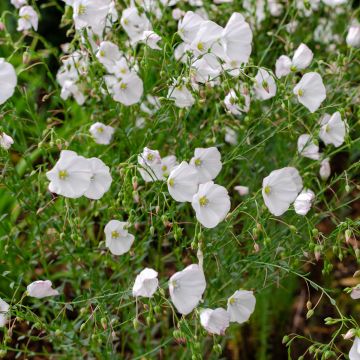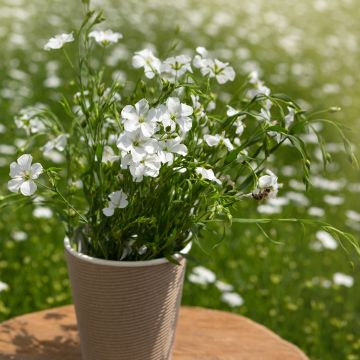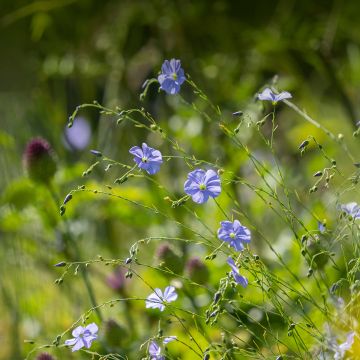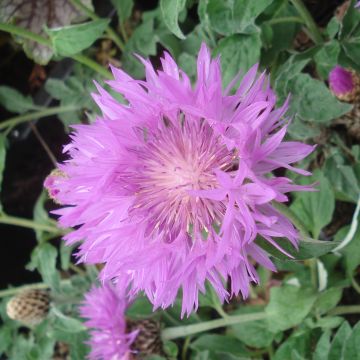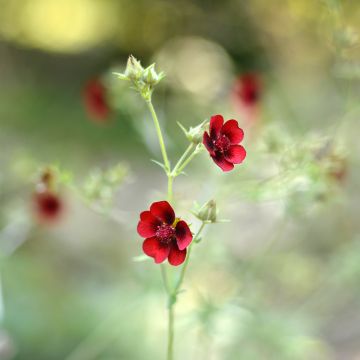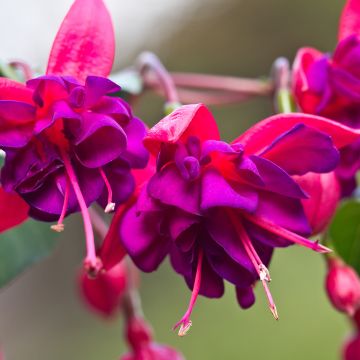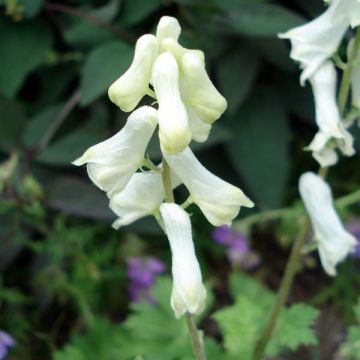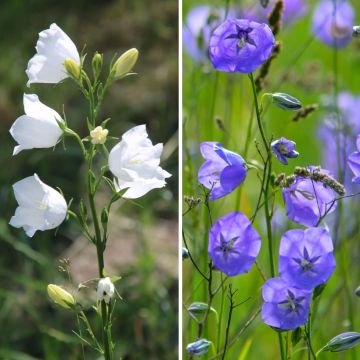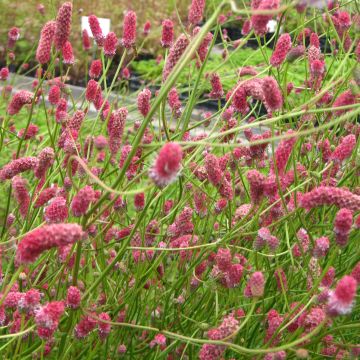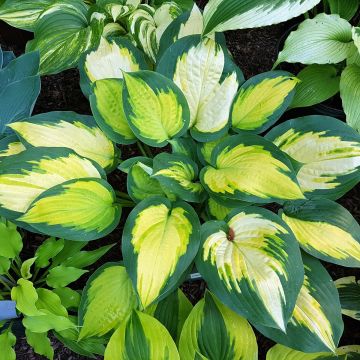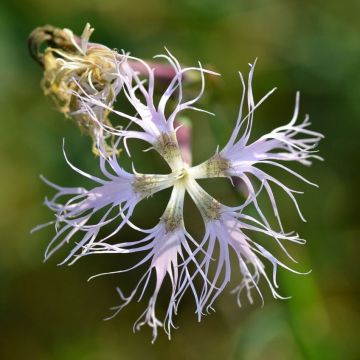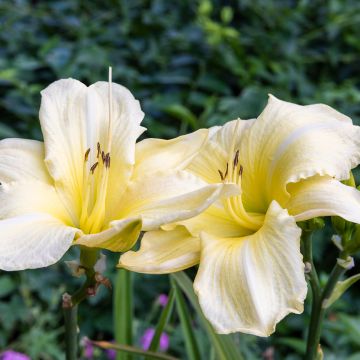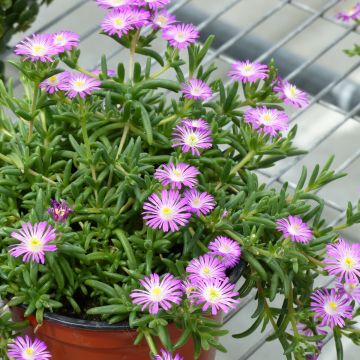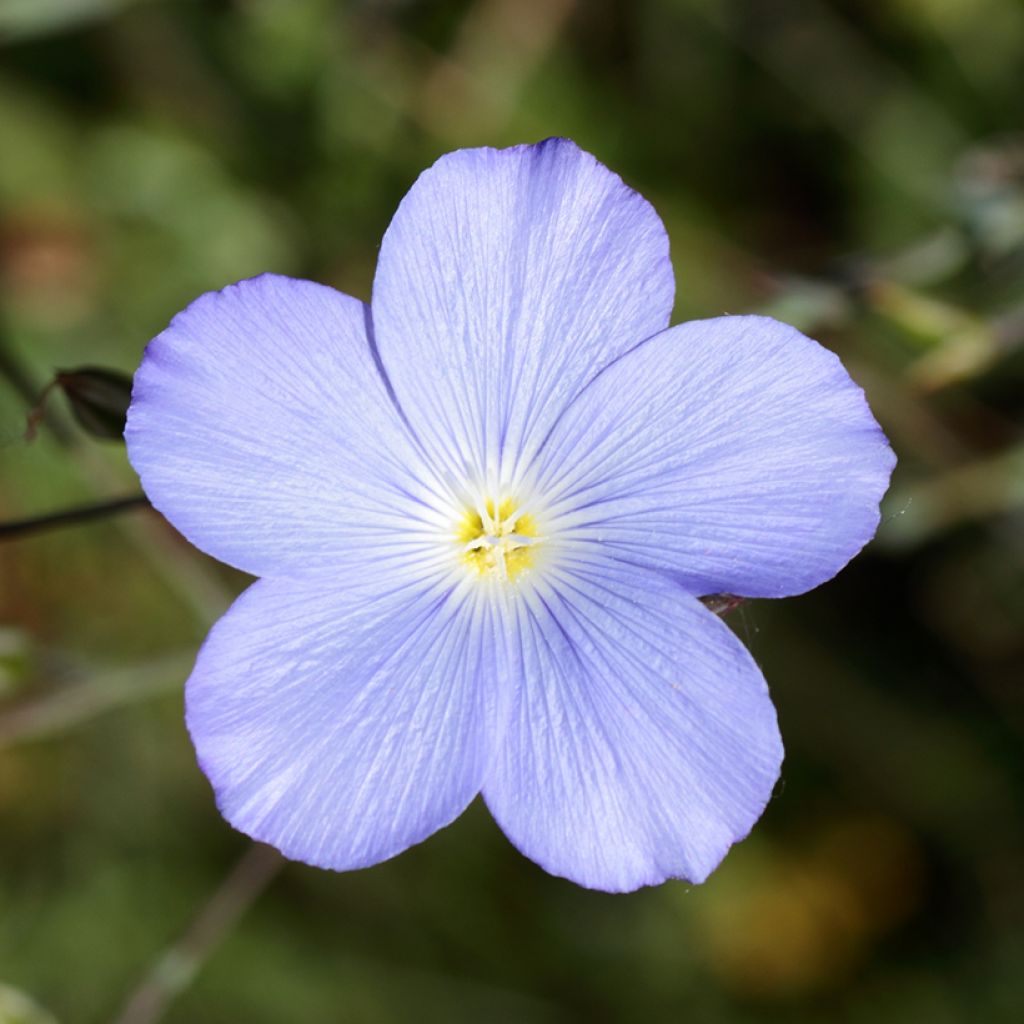

Linum perenne Saphir - Lin vivace
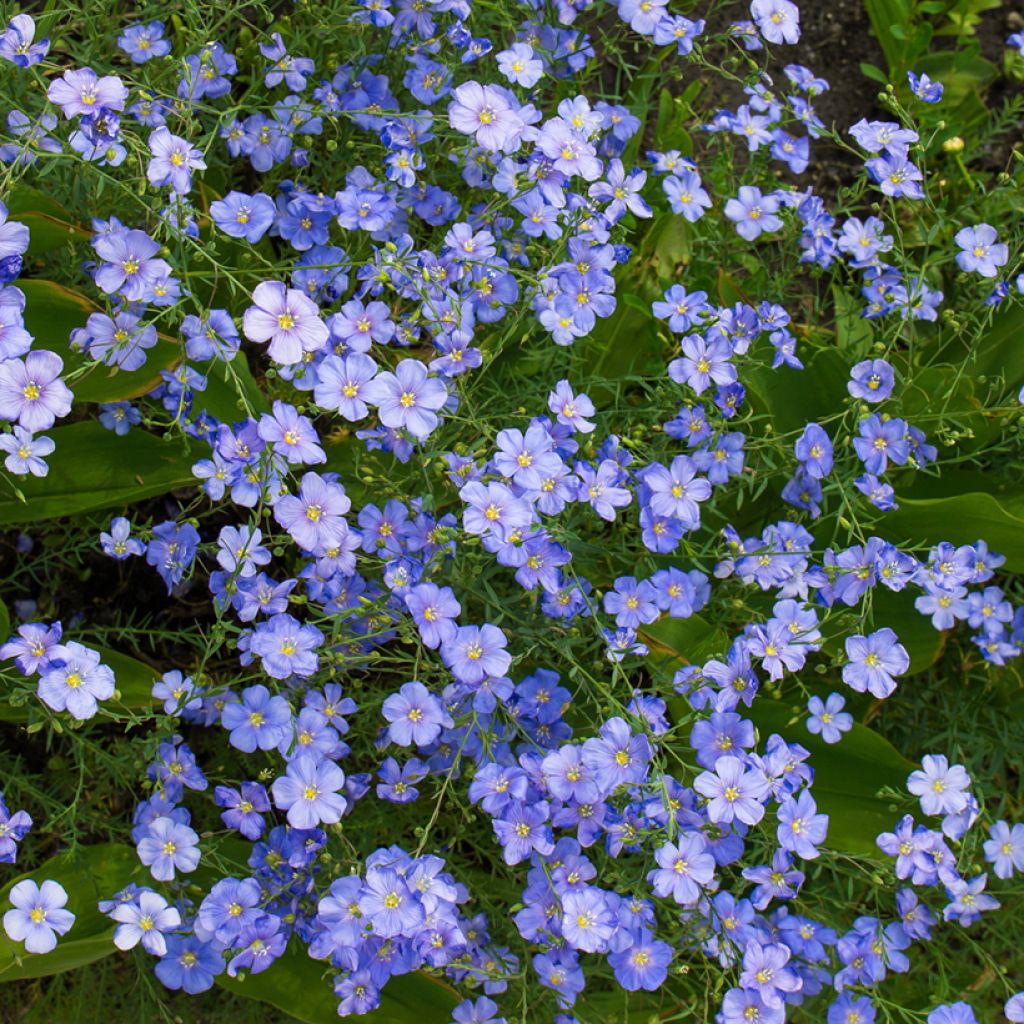

Linum perenne Saphir - Lin vivace
Linum perenne Saphir - Perennial Flax
Linum perenne Saphir
Perennial Flax, Blue Flax, Lint Bells, Prairie flax
This item cannot be shipped to the selected country
Delivery charge from €5.90
More information
Schedule delivery date,
and select date in basket
This plant carries a 12 months recovery warranty
More information
We guarantee the quality of our plants for a full growing cycle, and will replace at our expense any plant that fails to recover under normal climatic and planting conditions.
From €5.90 for pickup delivery and €6.90 for home delivery
Express home delivery from €8.90.

Does this plant fit my garden?
Set up your Plantfit profile →
Description
The Linum perenne Saphir is a variety of perennial flax that is small in size. It forms a bushy clump and offers bouquets of ephemeral flowers of the most beautiful sky blue colour, above a very fine foliage, slightly bluish green. They wither once the sun sets, but constantly renew themselves; for two to three months, they offer a lovely swirling spectacle that is always renewed. Perennial flax appreciates the sun, light, rocky soils, even dry ones. Plant it in sunny flower beds or rockeries, it brings a nice countryside touch to any decor.
The Linum perenne is a plant native to Siberia, Europe, and temperate Asia, belonging to the linaceae family. The Linum perenne Saphir is a more compact horticultural selection. It is a small, hardy perennial plant, with a short lifespan, forming a bouquet of delicate stems adorned with persistent green-blue foliage, composed of very fine leaves. When in bloom, the Linum perenne Saphir forms small bushy clumps, 30 cm (12in) in height and 30 cm (12in) in width. The flowering spreads, depending on the regions, from May to June (in hot and dry climates) or from July to September, in the form of bouquets of five-petaled flowers, funnel-shaped, 2 to 3 cm (1in) in size. They are of an intense light blue colour, finely veined with darker blue, with a satin texture. This plant, often grown as a biennial, readily self-seeds in light, sandy, or rocky soil. Very hardy, it forms a evergreen rounded clump in winter.
Flax is unrivaled, just like Nigella, for lightening up flower beds and adding a touch of naturalness to sophisticated scenes. They suffer from somewhat precarious health, which often makes them disappear within a few years, but they naturalize easily. Plant perennial flax without moderation in rockeries, meadows, borders, flower beds, or beds with light soil, alongside Grasses. Amidst Iris germanica, perennial flax lightens the sword-shaped foliage, fills the space between the stems, and takes over once their flowering is over. It also performs well in pots. Its elegance pairs well with gray-foliaged plants like Senecio cineraria, Artemisias, Lavenders, California Poppies, which require the same growing conditions. Like Perennial Geraniums, blue flax is a lovely companion for Peonies and Old-fashioned Roses.
Report an error about the product description
Flowering
Foliage
Plant habit
Botanical data
Linum
perenne
Saphir
Linaceae
Perennial Flax, Blue Flax, Lint Bells, Prairie flax
Cultivar or hybrid
Other Linus - Ornamental Flax
Planting and care
The Linum perenne flourishes in a sunny exposure. It withstands salt sprays. Plant it in a fresh, light, and well-drained soil. It fears winter humidity, which is why it is necessary to have a dry soil in winter. Once well rooted, it can do without watering in summer. Heavy and wet soils are not appreciated. When planting, space the Linums 15-20 cm (6-8in) apart. For a mass effect, it is advisable to plant them in clusters grouping about ten young plants. Cut back the cluster to 10 cm (4in) from the ground after flowering to promote new shoots.
Planting period
Intended location
Care
-
, onOrder confirmed
Reply from on Promesse de fleurs
Summer flowering perennials
Haven't found what you were looking for?
Hardiness is the lowest winter temperature a plant can endure without suffering serious damage or even dying. However, hardiness is affected by location (a sheltered area, such as a patio), protection (winter cover) and soil type (hardiness is improved by well-drained soil).

Photo Sharing Terms & Conditions
In order to encourage gardeners to interact and share their experiences, Promesse de fleurs offers various media enabling content to be uploaded onto its Site - in particular via the ‘Photo sharing’ module.
The User agrees to refrain from:
- Posting any content that is illegal, prejudicial, insulting, racist, inciteful to hatred, revisionist, contrary to public decency, that infringes on privacy or on the privacy rights of third parties, in particular the publicity rights of persons and goods, intellectual property rights, or the right to privacy.
- Submitting content on behalf of a third party;
- Impersonate the identity of a third party and/or publish any personal information about a third party;
In general, the User undertakes to refrain from any unethical behaviour.
All Content (in particular text, comments, files, images, photos, videos, creative works, etc.), which may be subject to property or intellectual property rights, image or other private rights, shall remain the property of the User, subject to the limited rights granted by the terms of the licence granted by Promesse de fleurs as stated below. Users are at liberty to publish or not to publish such Content on the Site, notably via the ‘Photo Sharing’ facility, and accept that this Content shall be made public and freely accessible, notably on the Internet.
Users further acknowledge, undertake to have ,and guarantee that they hold all necessary rights and permissions to publish such material on the Site, in particular with regard to the legislation in force pertaining to any privacy, property, intellectual property, image, or contractual rights, or rights of any other nature. By publishing such Content on the Site, Users acknowledge accepting full liability as publishers of the Content within the meaning of the law, and grant Promesse de fleurs, free of charge, an inclusive, worldwide licence for the said Content for the entire duration of its publication, including all reproduction, representation, up/downloading, displaying, performing, transmission, and storage rights.
Users also grant permission for their name to be linked to the Content and accept that this link may not always be made available.
By engaging in posting material, Users consent to their Content becoming automatically accessible on the Internet, in particular on other sites and/or blogs and/or web pages of the Promesse de fleurs site, including in particular social pages and the Promesse de fleurs catalogue.
Users may secure the removal of entrusted content free of charge by issuing a simple request via our contact form.
The flowering period indicated on our website applies to countries and regions located in USDA zone 8 (France, the United Kingdom, Ireland, the Netherlands, etc.)
It will vary according to where you live:
- In zones 9 to 10 (Italy, Spain, Greece, etc.), flowering will occur about 2 to 4 weeks earlier.
- In zones 6 to 7 (Germany, Poland, Slovenia, and lower mountainous regions), flowering will be delayed by 2 to 3 weeks.
- In zone 5 (Central Europe, Scandinavia), blooming will be delayed by 3 to 5 weeks.
In temperate climates, pruning of spring-flowering shrubs (forsythia, spireas, etc.) should be done just after flowering.
Pruning of summer-flowering shrubs (Indian Lilac, Perovskia, etc.) can be done in winter or spring.
In cold regions as well as with frost-sensitive plants, avoid pruning too early when severe frosts may still occur.
The planting period indicated on our website applies to countries and regions located in USDA zone 8 (France, United Kingdom, Ireland, Netherlands).
It will vary according to where you live:
- In Mediterranean zones (Marseille, Madrid, Milan, etc.), autumn and winter are the best planting periods.
- In continental zones (Strasbourg, Munich, Vienna, etc.), delay planting by 2 to 3 weeks in spring and bring it forward by 2 to 4 weeks in autumn.
- In mountainous regions (the Alps, Pyrenees, Carpathians, etc.), it is best to plant in late spring (May-June) or late summer (August-September).
The harvesting period indicated on our website applies to countries and regions in USDA zone 8 (France, England, Ireland, the Netherlands).
In colder areas (Scandinavia, Poland, Austria...) fruit and vegetable harvests are likely to be delayed by 3-4 weeks.
In warmer areas (Italy, Spain, Greece, etc.), harvesting will probably take place earlier, depending on weather conditions.
The sowing periods indicated on our website apply to countries and regions within USDA Zone 8 (France, UK, Ireland, Netherlands).
In colder areas (Scandinavia, Poland, Austria...), delay any outdoor sowing by 3-4 weeks, or sow under glass.
In warmer climes (Italy, Spain, Greece, etc.), bring outdoor sowing forward by a few weeks.

































